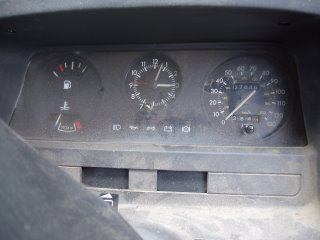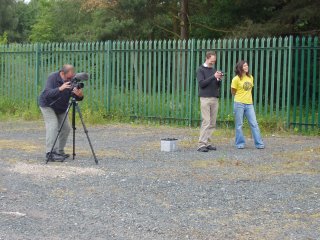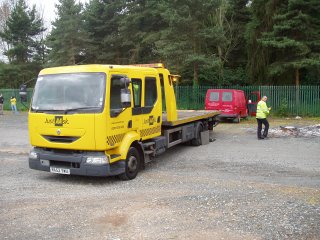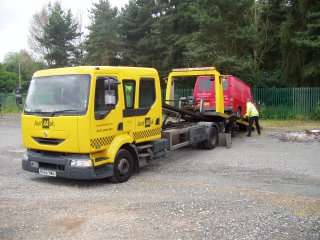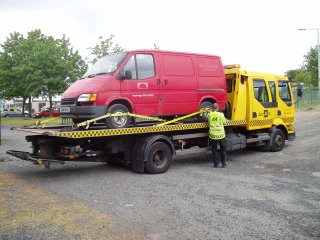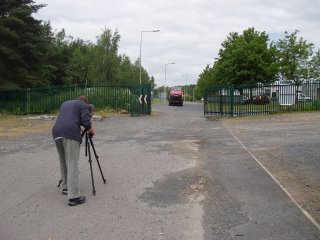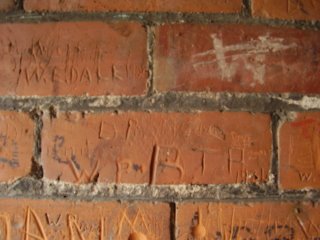Ironbridge Archaeology Van (ii)
This project aims to 'excavate' the old van in an archaeological manner, to try and learn what we can from it. Please scroll down for earlier posts.
Here are some more photographs from yesterday's removal of the van from Telford to Bristol. These photos were taken by Dr. John Schofield. Many thanks once again to Mark Grainger of the AA for his assistance with the move. We have also posted some comments on the merits (or otherwise) of project made by archaeologists and non-archaeologists. Please keep comments coming in, and/or vote on the BAJR poll.
 Greg Bailey (back to camera) interviews Paul Belford before the van is loaded onto the truck.
Greg Bailey (back to camera) interviews Paul Belford before the van is loaded onto the truck.
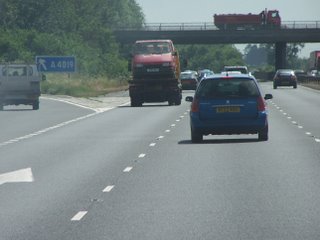 The van passing Junction 10, south- bound on the M5.
The van passing Junction 10, south- bound on the M5.
 Is there an engine in here? Mark Grainger of the AA inspects the vehicle after arrival in Bristol.
Is there an engine in here? Mark Grainger of the AA inspects the vehicle after arrival in Bristol.
Some comments...
"I am racking my brains as to what I may have left in it.........."
Glen Lawes, Chief Executive, Ironbridge Gorge Museum Trust
"I have a vivid memory of breaking down (clutch went) on the Eastern Primary in the van on the way to Birmingham some time ago - I had to borrow that one because the 'L' reg (the more refined of the two, bigger, cleaner and which had a cab wall for noise reduction) was in use."
Barbara Taylor, Graphics Department, Ironbridge Gorge Museum Trust
"Whilst I have every respect for the discipline and the hard graft of all the Ironbridge archaeologists - this project does seem a bit of a waste of time/resources and the subsequent report following forensic investigation of the van may not shed too much new light on the socio/economic or indeed technological histories of vans or indeed archaeologists. Is there a danger of disappearing up the proverbial arsehole?"
Harriet Devlin, Lecturer in Historic Environment Conservation, University of Birmingham
"What a stupid waste of time... Haven't they got anything better to do with their time? ARCHAEOLOGY INDEED! WHAT IS THE WORLD COMING TO? ... we should be paid more so that we can drive around the country in the RED van and round up all of the people who think it is worth while to EXCAVATE A VAN and send them to Mars on a big space ship."
Sophie Watson, Field Officer, Ironbridge Archaeology
"I think it is useful as a way of questioning and/or refining archaeological methodology – as it shows how ridiculous some archaeological theory is becoming."
Katie Page-Smith, Landscape Investigator, English Heritage
"An excellent form of madness if ever I saw one. I love all this kind of stuff. I agree that a site would be better to excavate than a van though, perhaps a site hut on the last day of a long job... It is best if your analogous material has as much similarity to your subject matter as possible. What can you compare a van to? boats? cartwheels? ... If nothing else this kind of work highlights the fact that archaeology is a practice and process of inhabitation: building upon the activities of the people we study. Mind you, anyone who has looked down on a big ditch section at the end of a hard day's work can tell you that. After years of thinking about ditches I still can't say clearly what ditches 'mean', but I think I know what it 'means' to have spent all day cleaning the silt out of one and seen water flow down it again ... I suspect that your efforts are doomed to failure."
'Tom Wilson', via the BAJR website.
"Sounds like a load of old rubbish to me" [with a (presumably ironic) link to the Suffolk County Council ‘Garbology’ page].
‘Vulpes’, via the BAJR website.
Here are some more photographs from yesterday's removal of the van from Telford to Bristol. These photos were taken by Dr. John Schofield. Many thanks once again to Mark Grainger of the AA for his assistance with the move. We have also posted some comments on the merits (or otherwise) of project made by archaeologists and non-archaeologists. Please keep comments coming in, and/or vote on the BAJR poll.
 Greg Bailey (back to camera) interviews Paul Belford before the van is loaded onto the truck.
Greg Bailey (back to camera) interviews Paul Belford before the van is loaded onto the truck. The van passing Junction 10, south- bound on the M5.
The van passing Junction 10, south- bound on the M5. Is there an engine in here? Mark Grainger of the AA inspects the vehicle after arrival in Bristol.
Is there an engine in here? Mark Grainger of the AA inspects the vehicle after arrival in Bristol.Some comments...
"I am racking my brains as to what I may have left in it.........."
Glen Lawes, Chief Executive, Ironbridge Gorge Museum Trust
"I have a vivid memory of breaking down (clutch went) on the Eastern Primary in the van on the way to Birmingham some time ago - I had to borrow that one because the 'L' reg (the more refined of the two, bigger, cleaner and which had a cab wall for noise reduction) was in use."
Barbara Taylor, Graphics Department, Ironbridge Gorge Museum Trust
"Whilst I have every respect for the discipline and the hard graft of all the Ironbridge archaeologists - this project does seem a bit of a waste of time/resources and the subsequent report following forensic investigation of the van may not shed too much new light on the socio/economic or indeed technological histories of vans or indeed archaeologists. Is there a danger of disappearing up the proverbial arsehole?"
Harriet Devlin, Lecturer in Historic Environment Conservation, University of Birmingham
"What a stupid waste of time... Haven't they got anything better to do with their time? ARCHAEOLOGY INDEED! WHAT IS THE WORLD COMING TO? ... we should be paid more so that we can drive around the country in the RED van and round up all of the people who think it is worth while to EXCAVATE A VAN and send them to Mars on a big space ship."
Sophie Watson, Field Officer, Ironbridge Archaeology
"I think it is useful as a way of questioning and/or refining archaeological methodology – as it shows how ridiculous some archaeological theory is becoming."
Katie Page-Smith, Landscape Investigator, English Heritage
"An excellent form of madness if ever I saw one. I love all this kind of stuff. I agree that a site would be better to excavate than a van though, perhaps a site hut on the last day of a long job... It is best if your analogous material has as much similarity to your subject matter as possible. What can you compare a van to? boats? cartwheels? ... If nothing else this kind of work highlights the fact that archaeology is a practice and process of inhabitation: building upon the activities of the people we study. Mind you, anyone who has looked down on a big ditch section at the end of a hard day's work can tell you that. After years of thinking about ditches I still can't say clearly what ditches 'mean', but I think I know what it 'means' to have spent all day cleaning the silt out of one and seen water flow down it again ... I suspect that your efforts are doomed to failure."
'Tom Wilson', via the BAJR website.
"Sounds like a load of old rubbish to me" [with a (presumably ironic) link to the Suffolk County Council ‘Garbology’ page].
‘Vulpes’, via the BAJR website.


